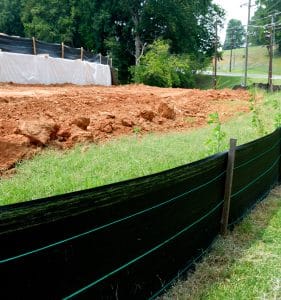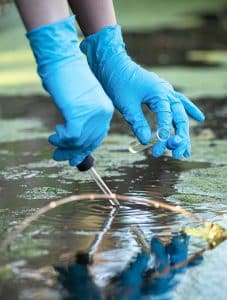Understanding and adhering to environmental regulations is not just the right thing to do; it’s also essential to the success and reputation of your industrial business. A critical part of this compliance puzzle is developing a Stormwater Pollution Prevention Plan (SWPPP). This blog post aims to provide an easy-to-follow guide on how to create an effective Industrial SWPPP.
Understanding the Importance of an Industrial SWPPP
In the intricate dance of industrial operations, the Stormwater Pollution Prevention Plan (SWPPP) takes center stage. But why, you might ask, should you pay attention to this regulatory requirement?
The SWPPP is far from being merely a tick-box exercise to appease environmental authorities. It’s a crucial strategic tool designed to help your facility minimize its environmental impact, enhancing your green credentials in an increasingly eco-conscious world.
Delving into the heart of your industrial operations, the SWPPP maps out potential pollution sources and charts a course for mitigating their impact. It’s your tactical guide, detailing preventive measures, laying out plans for tackling spills, and offering a framework for employee training. It’s your go-to document when the unexpected happens, ensuring that you can respond rapidly and effectively to keep pollution in check.
The benefits of a well-crafted SWPPP doesn’t stop there. Beyond helping you safeguard the environment, it also protects your bottom line. By enabling your facility to prevent stormwater pollution, it keeps you out of the regulatory crosshairs, saving you from potential fines that can run into the thousands, or even millions, of dollars. The SWPPP is your shield against non-compliance and the financial penalties. The cost of noncompliance with SWPPP regulations can be steep, with fines of up to 50,000 PER DAY
On a larger scale, your SWPPP serves as your pledge to the world. It’s a clear signal of your commitment to responsible operations, demonstrating to customers, investors, and the wider public that you’re serious about sustainability. This commitment can boost your reputation, fostering trust and respect in your brand.
In essence, an effective Industrial SWPPP is your passport to compliant, responsible, and profitable operations. It’s a valuable tool that not only guides you in navigating the regulatory landscape but also helps you make a positive contribution to the environment. With the right SWPPP in place, you’re equipped to turn environmental responsibility into a strategic advantage.
Identifying Potential Sources of Stormwater Pollution
What are some common sources of stormwater pollution in industrial settings?
Kickstarting your SWPPP journey starts with pinpointing where stormwater pollution could emerge within your facility. This requires a keen eye and thorough evaluation of all industrial activity zones. Where could pollutants such as grease, oil, heavy metals, chemicals, or sediments be lurking? You’d want to scrutinize areas like outdoor storage spaces, waste disposal areas, equipment maintenance zones, and loading docks.
As you conduct this audit, remember the stakes are high. Identifying these potential pollutants isn’t just about checking a regulatory box. Each source you spot and account for in your SWPPP is a step towards safeguarding our environment, maintaining regulatory compliance.
Be meticulous in your search. Investigate areas where industrial materials are stored or used, waste is generated or disposed of, and machinery is maintained or cleaned. Don’t forget about less obvious sources such as vehicle and equipment wash-down areas, rooftops, and parking lots, as these can also contribute to stormwater pollution.
Remember, each facility is unique, with its specific operational processes and associated potential pollution sources. Hence, your search for pollution sources should be tailored to your site’s specific context.
Armed with this detailed pollution source map, you can now move on to the next crucial phase of your SWPPP development – selecting effective control measures. These measures, carefully matched to the identified pollution sources, will become your first line of defense in protecting our environment and your facility’s regulatory standing.
Don’t overlook any potential pollution source, however small or unlikely it may seem. It’s better to include too many potential sources in your SWPPP than too few. An accurate, thorough SWPPP is your passport to responsible, compliant, and sustainable operations.
Selecting Appropriate Control Measures
Choosing the right control measures is an art that balances simplicity and complexity. The palette of options ranges from the straightforward, like housekeeping practices, to the more intricate, such as advanced engineering controls. The perfect blend, however, is guided by the specific context of your facility, the nature of potential pollutants, and the commitment to minimize pollutant discharge into stormwater.
Imagine simple housekeeping practices as the base layer of your protection canvas. Regular cleaning and maintenance, proper storage of materials, and waste management form this layer. They’re the daily, uncomplicated actions that can make a significant difference. For example, regular sweeping and cleaning can prevent pollutants from building up and being washed away during a storm.
Next, visualize engineering controls as a more detailed layer, providing an added level of protection. These measures might include installing silt fences or sediment basins, using erosion control blankets, or even restructuring the landscape to redirect runoff away from potential pollutant sources. Each stroke in this layer is guided by a deep understanding of your facility’s layout, operational processes, and stormwater flow paths.
Then there’s the palette of advanced controls, like treatment systems that filter out pollutants from stormwater before it leaves your site. These measures are the high-definition details in your painting of protection, helping you achieve the goal of reducing pollutant discharge to the ‘maximum extent practicable.’
Remember, the effectiveness of these measures is not set in stone. It might take some experimenting, monitoring, and adjusting to find the right mix. Be ready to learn and adapt as you implement and assess the effectiveness of these control measures in practice. As always, the aim is to create an SWPPP that’s as dynamic and responsive as the industrial operations it oversees.
Creating a Plan to Respond to Spills and Leaks
An Industrial SWPPP requires a contingency plan for those rare but inevitable missteps. In the context of your SWPPP, this translates into a comprehensive strategy to manage spills and leaks effectively. Rather than being caught off guard, having a well-articulated response plan allows you to quickly neutralize potential pollution sources, minimizing their environmental impact.
Picture your spill response plan as your facility’s emergency response team. It’s primed for action, with clearly defined roles and responsibilities for all participants. Key elements to consider in crafting this plan include:
- identifying who will lead the response.
- What protective equipment is needed, and the correct cleanup and disposal methods for contaminated materials.
- Details such as emergency contact information, spill kit locations, and evacuation routes should also be outlined.
Consider scenarios that your facility could potentially encounter. Different spill types will necessitate diverse response strategies, so your plan should be robust enough to manage a wide range of incidents. Whether it’s a minor oil leak from a piece of machinery or a significant chemical spill, having a plan for every scenario ensures you’re well-prepared for any storm – quite literally.
On top of having a solid spill response plan, proactive steps can also be taken to minimize the chances of spills and leaks happening in the first place. Regular maintenance checks, proper storage of materials, and ongoing employee training can significantly reduce the likelihood of such incidents.
Remember, an effective spill response plan is more than a section in your SWPPP document. It’s a commitment to environmental stewardship, a testament to your facility’s dedication to mitigating potential pollution risks swiftly and efficiently. While spills and leaks may be part of doing business, your swift and structured response doesn’t have to amplify their environmental impact. Let your spill response plan turn a potential disaster into a well-rehearsed step in your industry’s performance.
Training Your Employees
The key to successfully steering this environmental stewardship vehicle lies in a well-trained crew. This pivotal journey on your SWPPP roadmap is all about ensuring your employees are not just familiar with, but fully immersed in, the details of your SWPPP.
Begin by charting out a comprehensive training plan that encompasses all elements of the SWPPP. This blueprint should be designed to cultivate an in-depth understanding of the plan, instill a deep appreciation of stormwater pollution prevention, and clarify the individual roles each team member will play.
Consider incorporating an engaging mix of theoretical knowledge and practical application in your training plan. This blend could include classroom-style sessions on the theoretical aspects of the SWPPP, alongside hands-on training in the field, where employees get to apply their learnings in real-world scenarios.
Remember, the ultimate goal is not just to impart knowledge but to build competencies and cultivate a team of environmental stewards who can adeptly navigate your industrial operations within the boundaries of the SWPPP.
Beyond just an initial orientation, consider regular refresher sessions. In order to keep up with compliance and new regulations, The Stormwater Training Center recommends SWPPP developers take a refresher course every 2 years. This learning approach can help cement the SWPPP principles in your team’s daily operations. The recurring training will also help reinforce the importance of each person’s role in protecting the environment and keeping your business compliant.
To further boost the efficacy of your training plan, consider leveraging a variety of teaching tools and resources. From instructional videos and interactive quizzes to job aids and hands-on demonstrations, using different training mediums can help cater to various learning styles, ensuring your team grasps and retains the SWPPP information.
Keep in mind, your SWPPP training should be an evolving initiative, adapting to changes in your operations, updates to the SWPPP, and emerging best practices. This dynamic approach to training will ensure your team stays current and competent, ready to effectively implement your SWPPP.
Regularly Reviewing and Updating Your SWPPP
Take a thoughtful look at your operations. Have there been changes in your processes, equipment, or materials used that could impact stormwater pollution? Has your facility expanded or changed its layout? All these factors can introduce new sources of potential pollution, which your SWPPP needs to account for.
Assess the effectiveness of your control measures.
- Are they performing as expected, or have there been issues?
- Are there areas where pollutants are still making their way into stormwater despite your control measures?
This could indicate that these measures need to be revisited, adjusted, or replaced to ensure maximum efficacy.
Consider the lessons learned from any incidents, such as spills or leaks. Did your response plan work as intended, or were there shortcomings that need to be addressed? Your experiences can provide valuable insights to fine-tune your SWPPP, helping you respond even more effectively to future incidents.
Lastly, align your SWPPP with any changes in regulations or industry best practices. Stay informed about updates to environmental regulations and emerging practices in stormwater pollution prevention. Integrating these updates into your SWPPP helps ensure it remains a robust, compliant, and effective tool.
In essence, your SWPPP is not a static document, frozen in time. Instead, it’s a dynamic blueprint for your facility’s ongoing commitment to environmental responsibility, shaped by your operational changes, lessons learned, and regulatory updates. So, embrace this process of regular review and updating as a vital step in your SWPPP journey.
Remember, a proactive, adaptable approach to your SWPPP is your best bet in navigating the complexities of industrial operations and environmental compliance.
